Plant Profiles dive deep on one plant variety each month. They are meant to provide you with enough information to make good growing decisions. A desire to grow gorgeous flowers is one thing. However, discerning if a particular plant is right for you and your climate is a whole other ballgame.
My intention here is to give you as much practical information to make these decisions. However, I’m going one step further and taking you completely behind the scenes to share exactly what has worked for us as well. For this reason, Plant Profiles are broken up into what I’m calling the “Nuts and Bolts (N&B)” and “Behind the Scenes (BTS).”
If you haven’t already, please be sure to read the FFY Introduction to learn more about how Plant Profiles are organized.
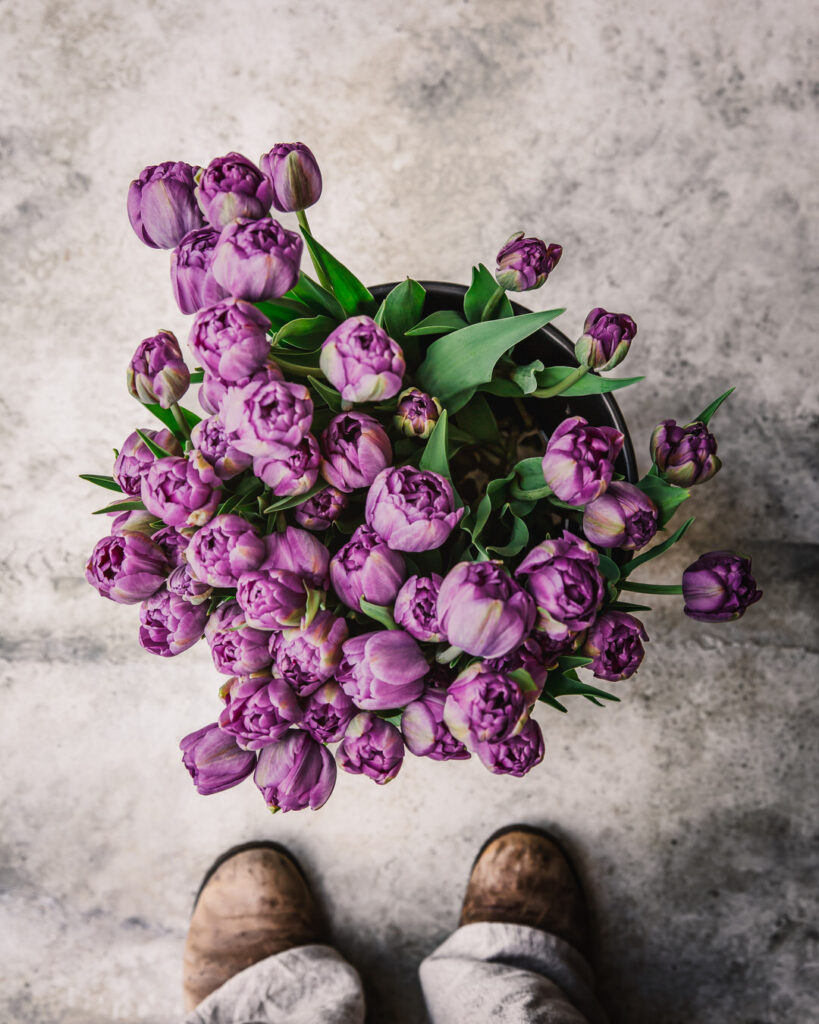
Primary Sources
The primary sources for the N&B portion come from:
- Postharvest Handling of Cut Flowers and Greens: A Practical Guide for Commercial Growers, Wholesalers & Retailers (Dole, Stamps, Carlson, et al).
- Specialty Cut Flowers, 2nd Edition, Revised & Enlarged (SCF): Industry standard for both new and experienced growers on the production of annuals, perennials, bulbs, and woody plants for fresh and dried cut flowers (Allan M. Amritage and Judy M. Laushman)
- Johnny’s Selected Seeds (Johnny’s): Johnny’s has been in the business for 50 years, with a research farm dedicated to finding the best seeds and tools for farmers and gardeners
- BOSTON Ornamental Terminal Prices. Specialty Crops Market News Federal – State Market News Service, USDA (as of 14-FEB-2023
- Wells, Genny. (2009) To Cut or Not to Cut – Tulips with bulbs attached. The Cut Flower Quarterly, Association of Specialty Cut Flower Growers, Issue 26, pp.20-23. Electronic copy of the study.
Zone Considerations
- Johnny’s Selected Seeds research farm is located in Zone 5a Maine
- JennieLove’s farm, Love n Fresh Flowers, is located in Zone 6B/7 Philadelphia
- SCF references research for Zones 3–9
- My farm, Petal Back Farm, is located in Zone 4b Wisconsin
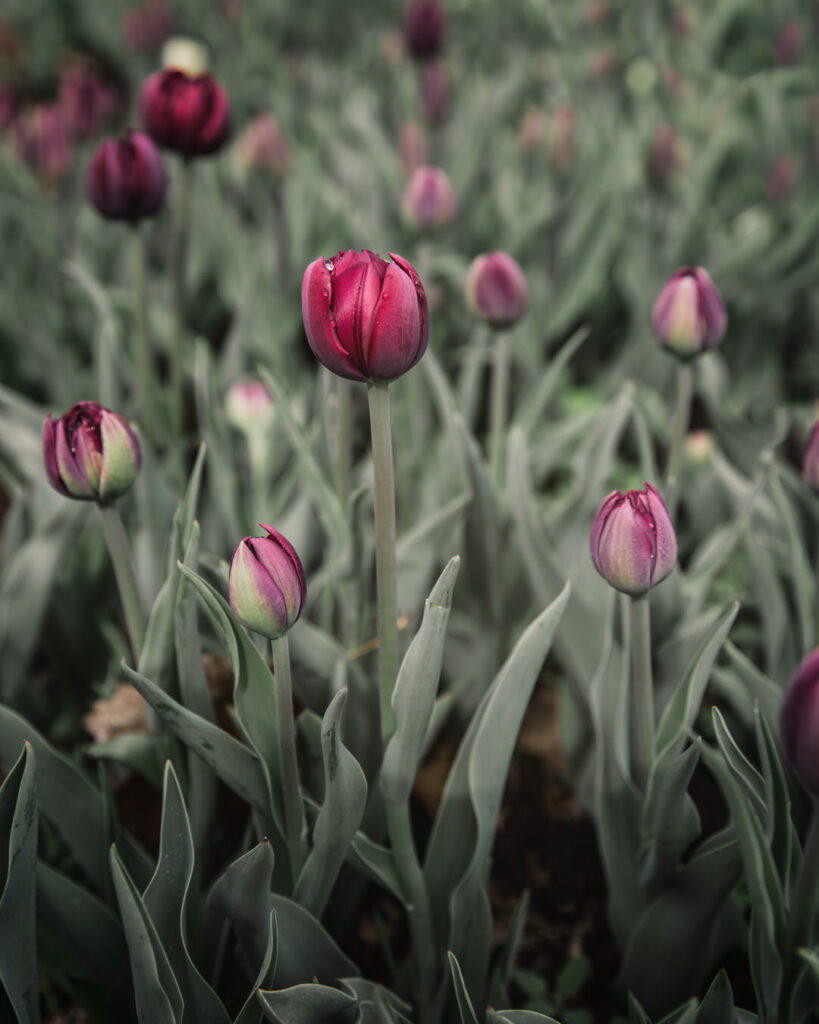
General Information: N&B
Latin Name Name: Tulipa
Common Name: Tulip
Origin: Asia Minor
Days to Maturity: Early to Mid-Spring
Life Cycle: Perennial
Spacing: For annual cut-flower production: Space bulbs ¼–½” apart, like eggs in an egg carton (as close together as possible without allowing the bulbs to touch each other). Tulips in landscape beds or garden beds: Space bulbs 1–6″ apart.
Height: Varies by variety
The origin of the modern tulip is not known, but a long period of cultivation occurred in Turkey and Iran prior to its introduction to Europe in the 16th Century. Today, most bulbs come from Holland (SCF). Garden tulips are divided into many classes based on parentage, flowering time, and flower form (SCF), and there are close 8,000 registered varieties (Ednie). The primary forms of tulips used for cut flower production include Darwin, Triumph, Rembrandt, Double, Single, Parrot, Peony, Fringed, and Lily-flowered.
With some exceptions, many of the hybrid tulips do not naturalize for dependable blooms year after year. For this reason, along with stem length and storage, most cut-flower farmers grow tulips as annuals. They are typically grown for spring markets, though more growers are forcing tulips in crates or hydroponics to extend the season.
According to Ednie, 7 billion tulips were grown last year alone, with more than half for cut-flower production. It’s clear that tulips are a spring darling not going anywhere any time soon!
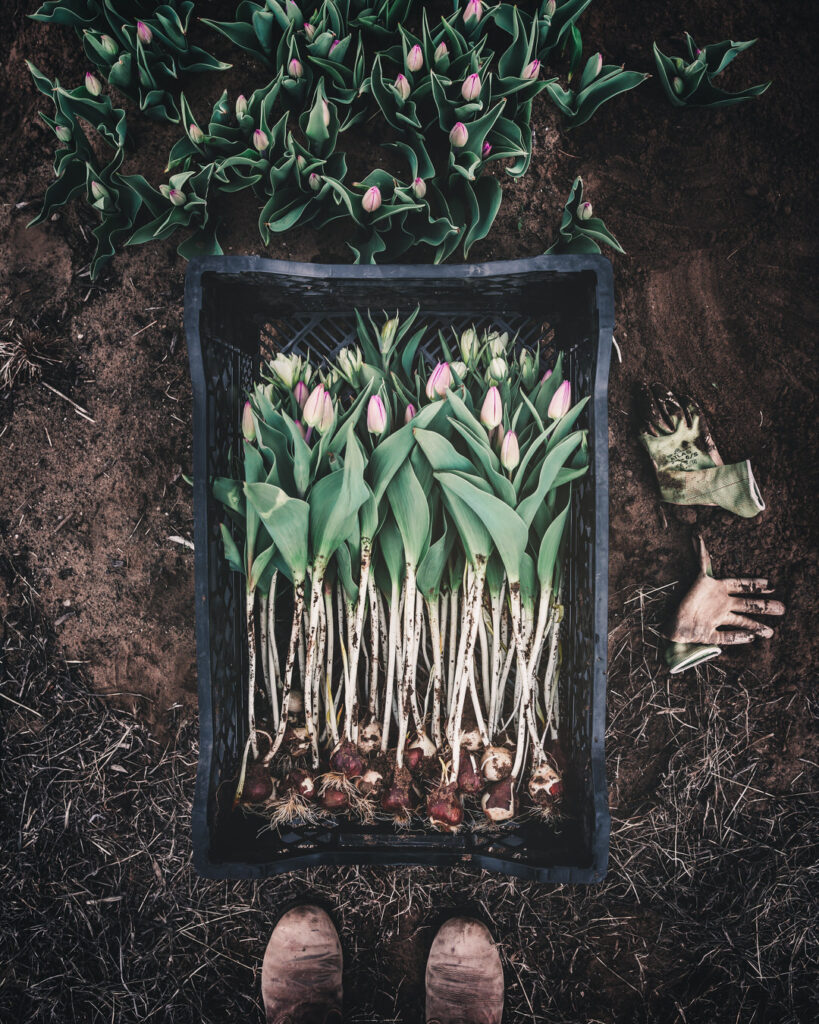
General Information: BTS
Being that we are in the midst of tulip season, I’m just swooning over them, so I figured why not dedicate May’s Plant Profile to tulips. Tulip season is fast and furious, so I’ll take all that I can get!
What I love most about tulips as a cut flower:
- Easy to grow
- Bloom at a time when everyone is super hungry for flowers
- Amazing array of colors and forms
- Great personality for design and bouquets
- Popular with florists, wholesale, and retail customers
- Nostalgic flower
- Can sell by the bunch
But every rose has its thorn, right? Potential shortcomings:
- Most varieties have little to no fragrance (with some exceptions)
- Stems can be a little weak for some varieties, especially in hand-tied bouquets
Propagation: N&B
Tulips are grown from bulbs, typically planted in the fall for spring production, so that is what we’ll focus on for this month. That said, tulips can be grown in various ways and locations:
- Inside or outside.
- In soil or on water (hydroponically).
- In crates, ground beds, or raised beds.
- In colder climates or warmer climates.
If you’re curious about forcing tulips, I’d check out Ednie’s Free Forcing Tulip Guide to get your feet wet. If you really want to dive deep on forcing tulips, I’d consider The Tulip Workshop. I haven’t taken it myself, but I’ve heard good things from fellow flower farmers.
Propagation: BTS
We grow tulips for spring production, planting in both the field and the high tunnel. At this time, we don’t force bulbs out of season. While it’s piqued my interest at times, I think it’s important to discern what’s not for you. While I find it fascinating to see how others are pushing the boundaries on what’s possible, I love the seasonality of farming and growing with the natural ebbs and flows of the season.
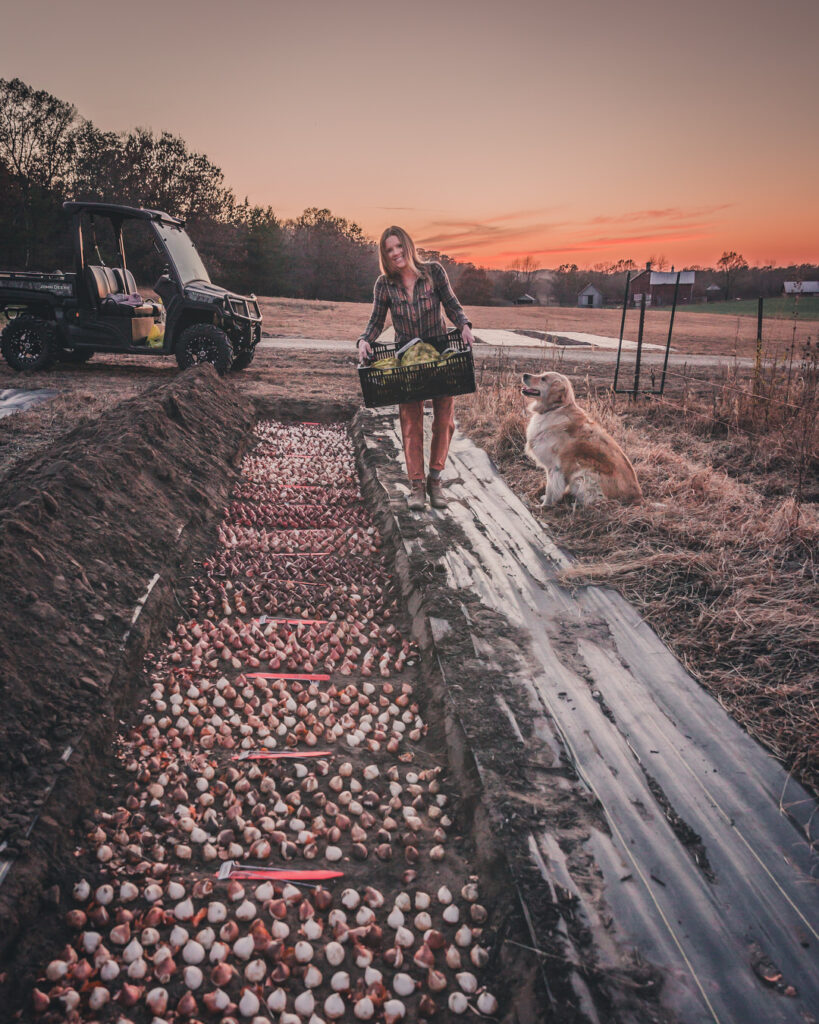
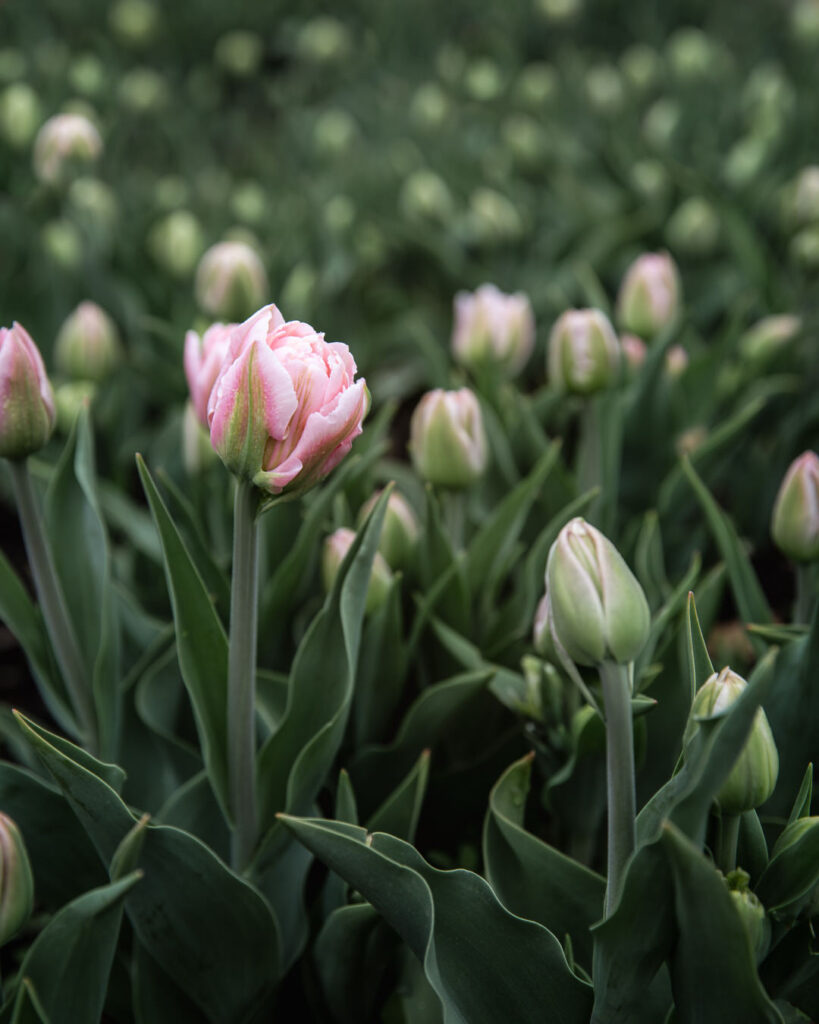
Environmental Factors: N&B
Temperature
Chilling during the bulb’s dormant period is required for flower development. This cooling treatment also causes acceleration of flowering, uniformity, and long stems (SCF). For this reason, growers in warmer zones should either purchase pre-chilled bulbs or chill their own. Bulbs should be pre-chilled at 38–45F (3–7C), for 6–12 weeks before planting. To pre-chill bulbs, place in a refrigerator for up to 12 weeks. Be careful not to store bulbs near fruit, especially apples (Johnny’s).
When purchasing pre-chilled bulbs, they are typically listed as 5C and 9C. According to Ednie, 5C Tulips have received the total amount of cooling as “dry” bulbs in cold storage prior to shipping. These tulips should be planted immediately upon arrival. Because they are ready to take off, extra attention must be given to the root systems. 5C. Tulips can be used in southern areas where the day temperatures do not get too warm and the night temperatures do not drop low enough for the tulips to receive enough cold weeks.
According to Ednie, 9C Tulips have received approximately 6 weeks of 9°C cooling prior to shipping. If the optimum number of weeks for a certain variety is 15, then these 6 weeks of “dry-cooling” can be subtracted, leaving an additional 9 weeks of cooling to be done at the grower’s facility. As with the 5C Tulips, 9C Tulips can also be used in areas where the cold period is not long enough for the tulips to complete the total number of cold weeks.
Site Selection
Bulbs require a well-drained soil with a pH of 6,0–7.0. While full sun is ideal, tulips will tolerate partial shade. However, they require at least 5–6 hours of sun per day at the time of bloom (Johnny’s).
Environmental Factors: BTS
Here in Zone 4, our winters are plenty cold, so we do not need to worry about pre-chilling our bulbs (finally, a benefit to our cold zone, HA!). Our tulips typically have more-than adequate stem length. Whenever they have been short, it’s usually because we had a flash of hot weather or not enough rain (I’ve found it’s important to keep them irrigated). We have extremely sandy soil, so drainage is no issue.
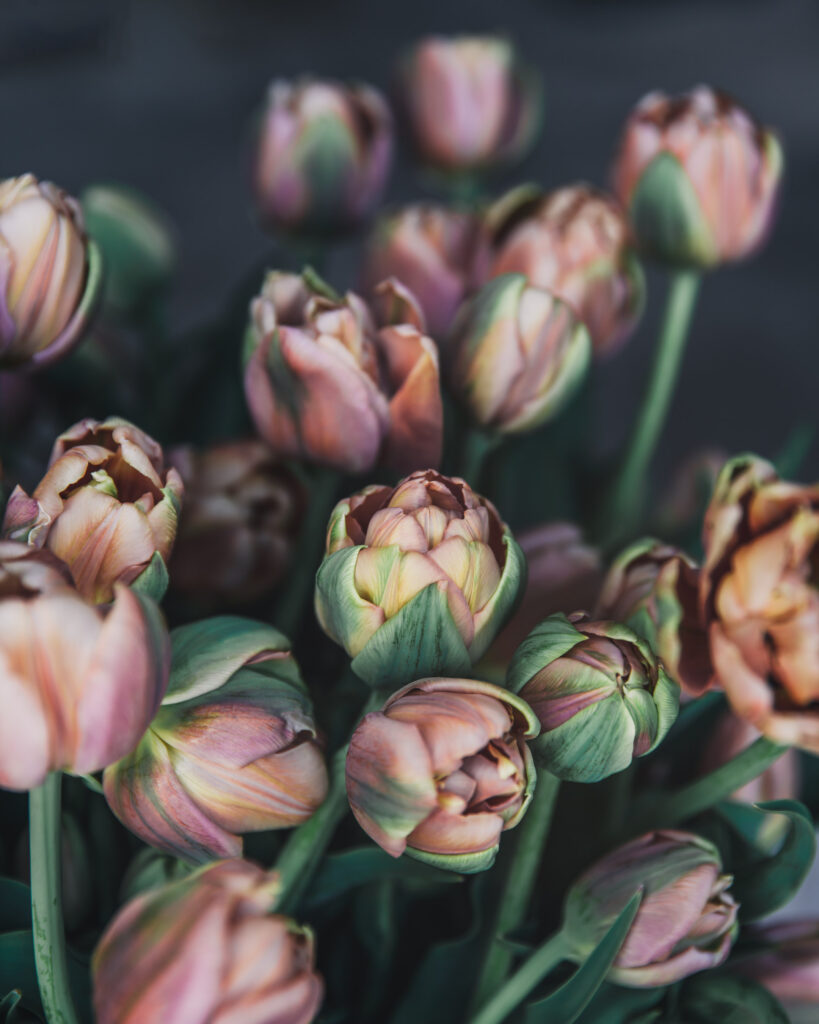
Planting: N&B
In most areas of the country, non-precooled bulbs should be planted in the fall. In the South (Zones 6b and 7b), plant in October to November; in the North (Zone 6 and lower) in September and early October. In the Deep South (e.g., Florida, south Texas, southern California), bulbs must be pre-cooled and planted in late November through December (SCF). Johnny’s recommends planting bulbs when the soil has cooled to 55F (13C) or lower, and nighttime temperatures consistently drop to 40–50F (4–10C), but before the ground freezes. Planting about 5 to 6 weeks before the ground freezes allows the bulbs sufficient time to develop roots.
According to Johnny’s, loosen the soil to a depth of 8–12″ to help ensure adequate root establishment. Most growers dig trenches or build rasied beds. Adding a layer of compost to the root zone at planting will also aid in root establishment and plant growth. Press bulbs, upright, into the prepared soil (with the pointed end up and the fatter, flat end down). Cover bulbs with soil 2½–3 times deeper than the bulb height, or deeper in locations with light soil. For example, a 1½” tall bulb should be covered with 4–5″ of soil. As a rule of thumb, planting a bit too deep is better than planting too shallow. Planting each bulb at the same depth will help ensure that they all bloom at the same time. Water immediately after fall planting. As long as the bulbs are planted in the field, normal rainfall should suffice in all but the driest climates.
Planting: BTS
We plant our bulbs trench style, 6–8 inches deep. Every year, I say I am going to try the raised-bed Jenny Love method, but then fall happens, and I never do. I either dig a trench or Matt digs out a trench with the tractor. I prefer the tractor method, ha, but it just depends on where the bed is going. I only water in the ones planted in the high tunnel. Our falls typically have a lot of rainfall and our winters a lot of snowfall, so moisture is not an issue.
I have planted our bulbs straight into Thanksgiving, without issue, even if on our cold zone (wholesale orders seem to continue to have delay after delay). I’m of the opinion that if the ground can be dug, you can still plant bulbs.

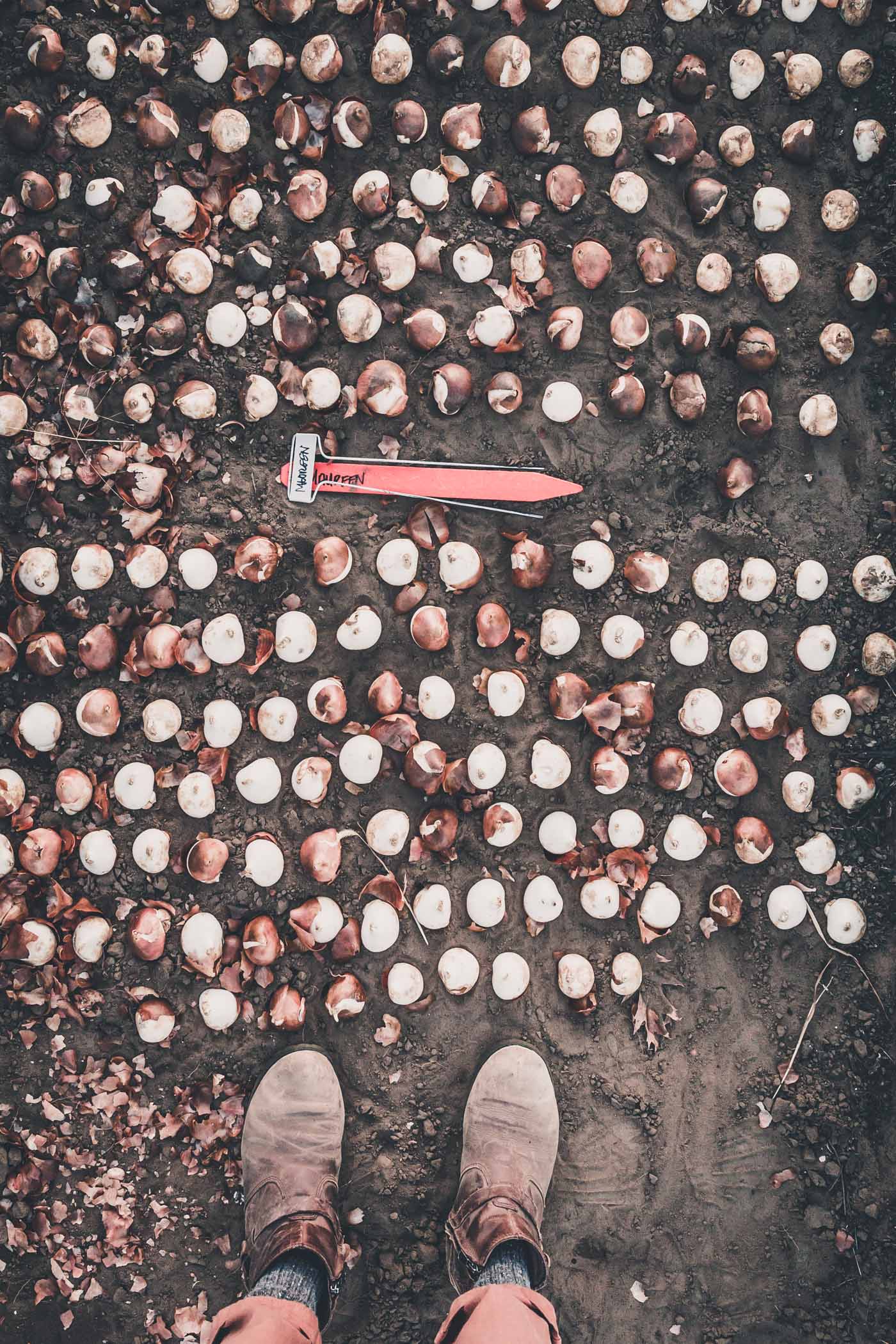

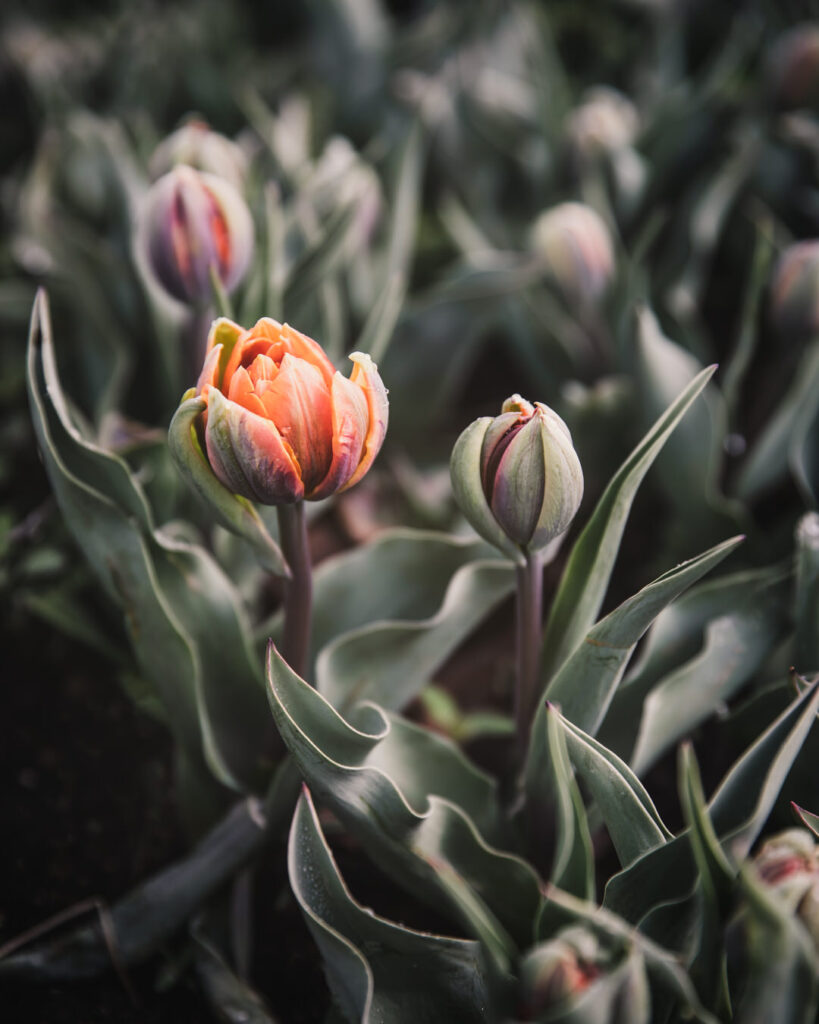
Succession & Groups: N&B
While not successions, per se, most sources recommend planting a variety of tulips with different bloom periods (early, mid, late) to extend the season. Below is a breakdown of the different groups, as described by Ednie:

Additionally, bulbs can be planted under a high tunnel or low tunnel for blooms 3 to 4 weeks earlier. The important thing to consider when planting under protection is making sure that tulips get adequate moisture.
Successions & Groups: BTS
I like to plant a variety of tulips from different groups in order to extend the season. In the Variety section, you’ll find a spreadsheet comparison of the many tulips we grow at the farm. This season was my first season growing in the high tunnel, and we did have blooms about one month earlier than the tulips in the field. I haven’t grown tulips under a low tunnel, but many growers report getting tulips up to a month earlier this way, so it seems like a good option for extending your harvest. The most important thing with growing in the tunnel is making sure that the bulbs get adequate moisture.
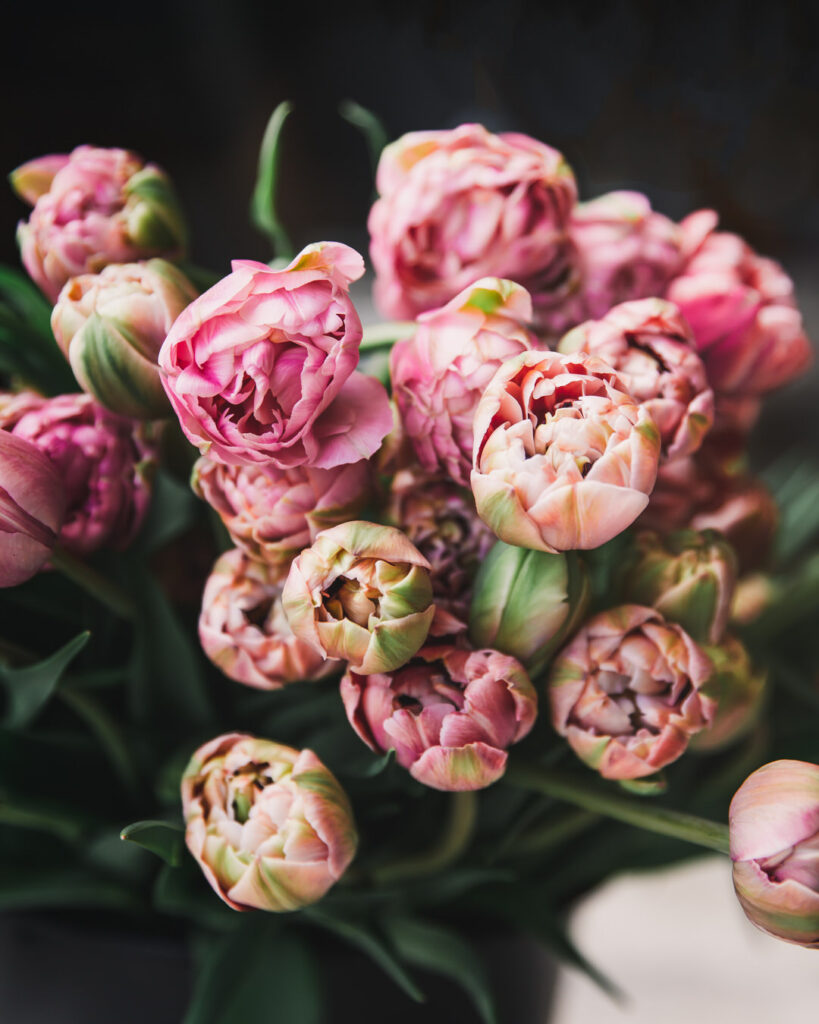
Nutrition: N&B
According to Johnny’s, first-year planted bulbs and those treated as annuals do not need fertilizer for flowering. Perennialized bulbs can benefit from the addition of compost or a slow-release bulb food on top of the soil from their second year one.
Nutrition: BTS
Regardless of what we grow, we compost our beds and add fertilizer based on our soil test. The only exception with tulips is that we do not add any nitrogen. If you’ve been around FFY, you’ve seen how we fertilize organically. If you’re new, you can access this PDF that breaks down exactly what we do here.

Drainage & Irrigation: N&B
Most sources recommend watering after fall planting and that normal rain and/or snowfall should suffice thereafter in all but the driest climates.
Drainage & Irrigation: BTS
I don’t water in our field-planted tulips because we get a lot of rain in the fall and snow in the winter. I do water in the tunnel-grown tulips well at planting and once shoots emerge in the spring. Tulips do not drying out, so I’ll water the field tulips if we haven’t gotten much rain.
Pinching: N&B
Tulips should not be pinched.
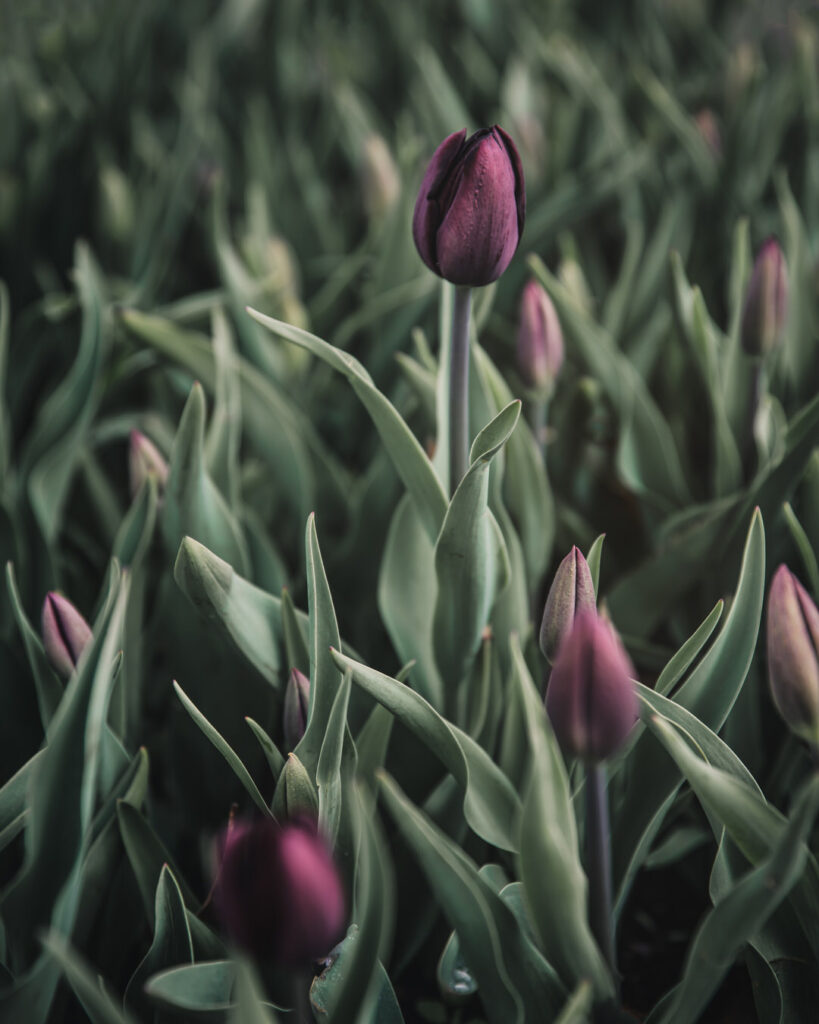
Bloom Period: N&B
Bloom period is highly depended on geographic location, environmental factors, and whether forcing, growing in a tunnel, or in the field. The length of time tulips may be harvested also depends on the use of early-, mid-, and late-season cultivars. The length of winter temperatures below 45F (7C) and the rate of spring warming also greatly impacts harvest window (SCF). Trials conducted in different ares of the country provided the following results:
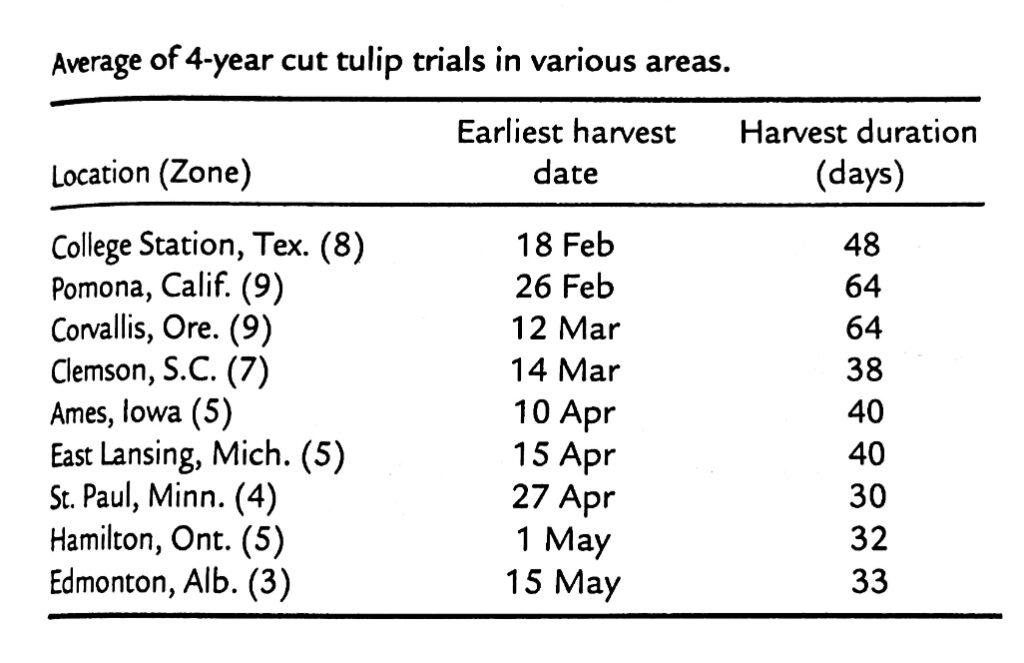
Bloom Period: BTS
Typically, we have tulips from April to mid- to late-May. Our springs can be vastly different year over year. Two years ago, we had field tulips start blooming in April. Last year, we didn’t have field tulips until after Mother’s Day.
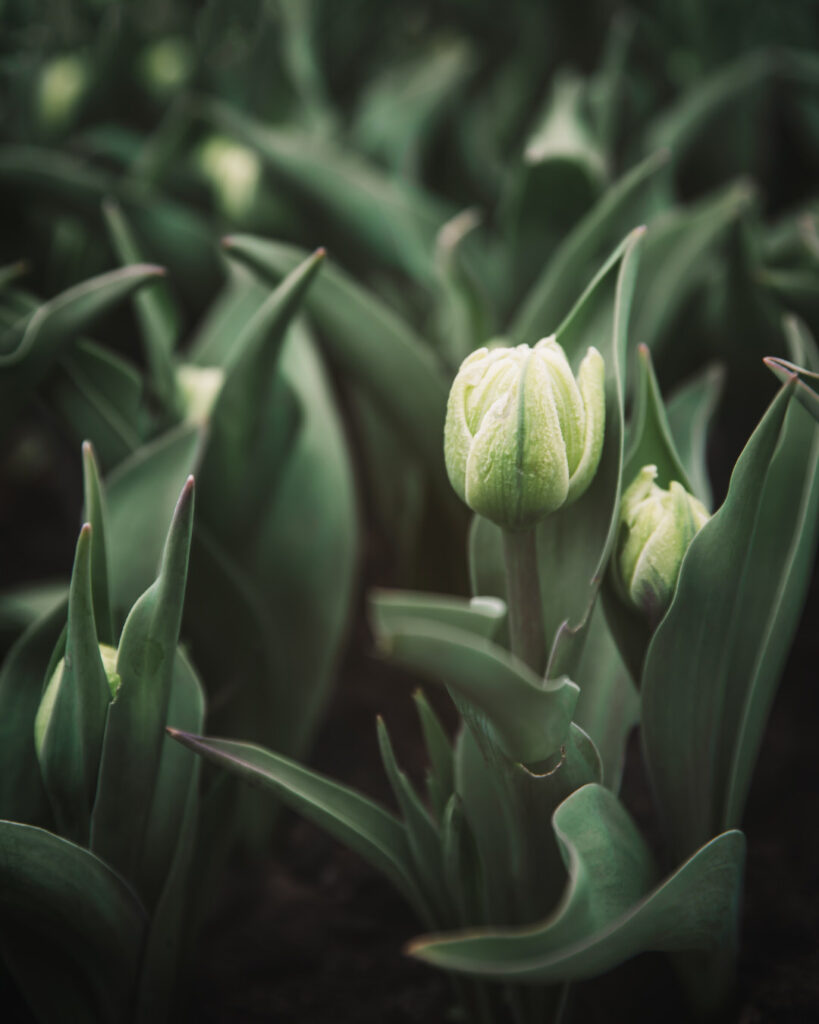
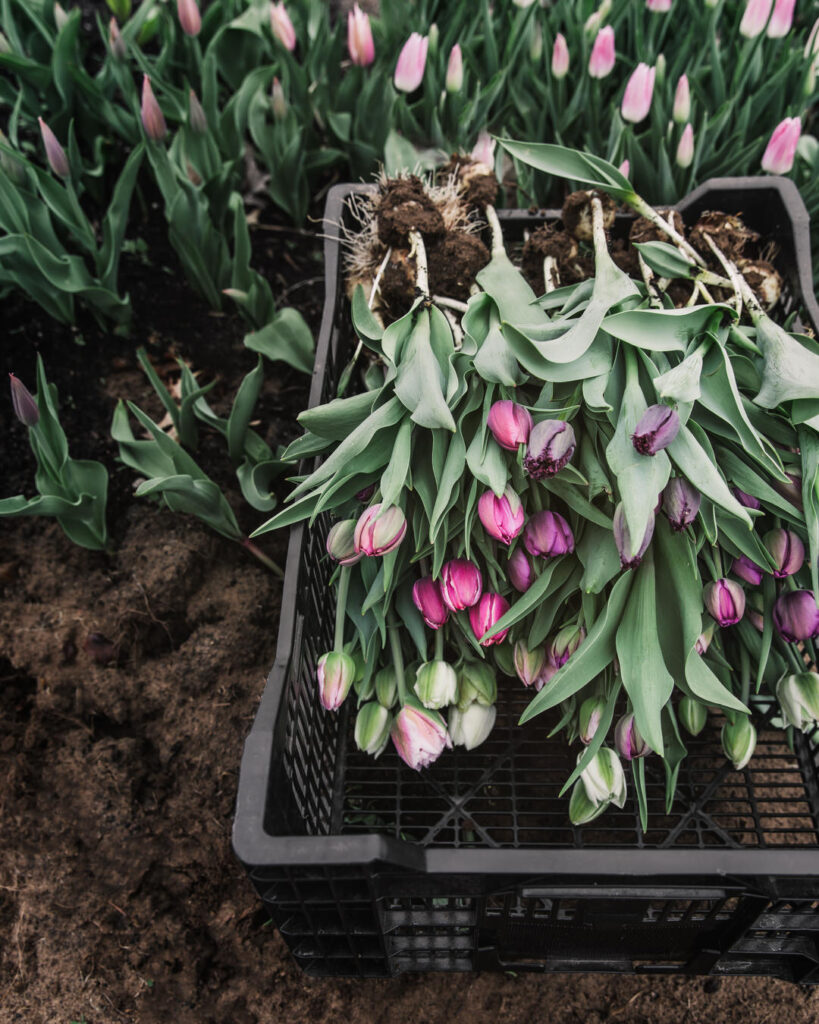
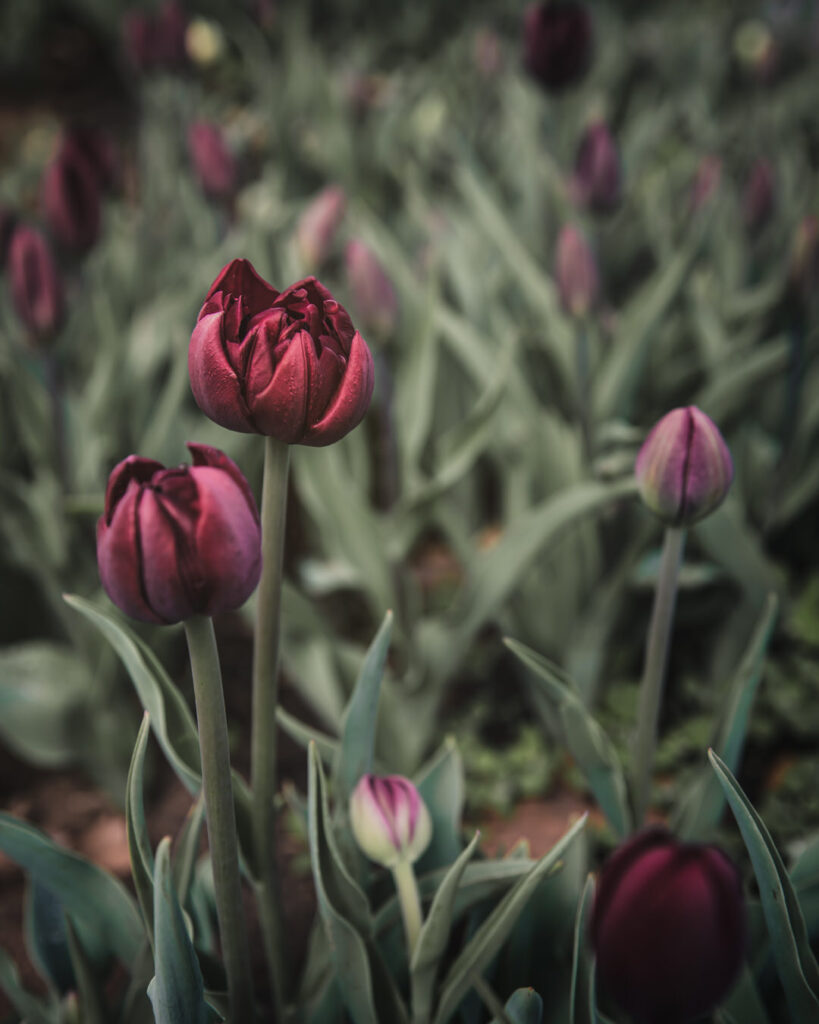
Harvest: N&B
While harvest time can vary based on variety, most sources recommend harvesting tulips when the flowers start to show color but before they begin to open (cracked bud). SCF recommends harvesting Darwin tulips when half the bloom starts to show color. During peak season, one may be harvesting tulips multiple times a day to get them at the right time.
Most growers harvest tulips with the bulb attached, which provides the tulips with a food source during long-term storage. Some simply wiggle and pull the entire tulip, bulb and all. Others use a pitchfork or shovel to loosen the soil prior to pulling. Most recommend standing tulips upright or wrapping in paper to keep stems straight during storage.
Harvest: BTS
We harvest exactly as recommended above, with the personal note that sometimes the peony tulips are a little hard to get right at first. You don’t want to harvest with the bud so tight that they fail to open, but they can also blow open super quickly! Occasionally, we can wiggle and pull straight out of the soil, but more often than not we need to use a pitchfork to loosen the soil. We harvest into black crates that the bulbs are shipped in. While I’ve seen growers stand these up vertically, we simply lay and stack them horizontally in the cooler with no issue. Sometimes we have tulips that are too tall for the crates. These are either stored in plastic bins without lids or wrapped in kraft paper and stacked horizontally.
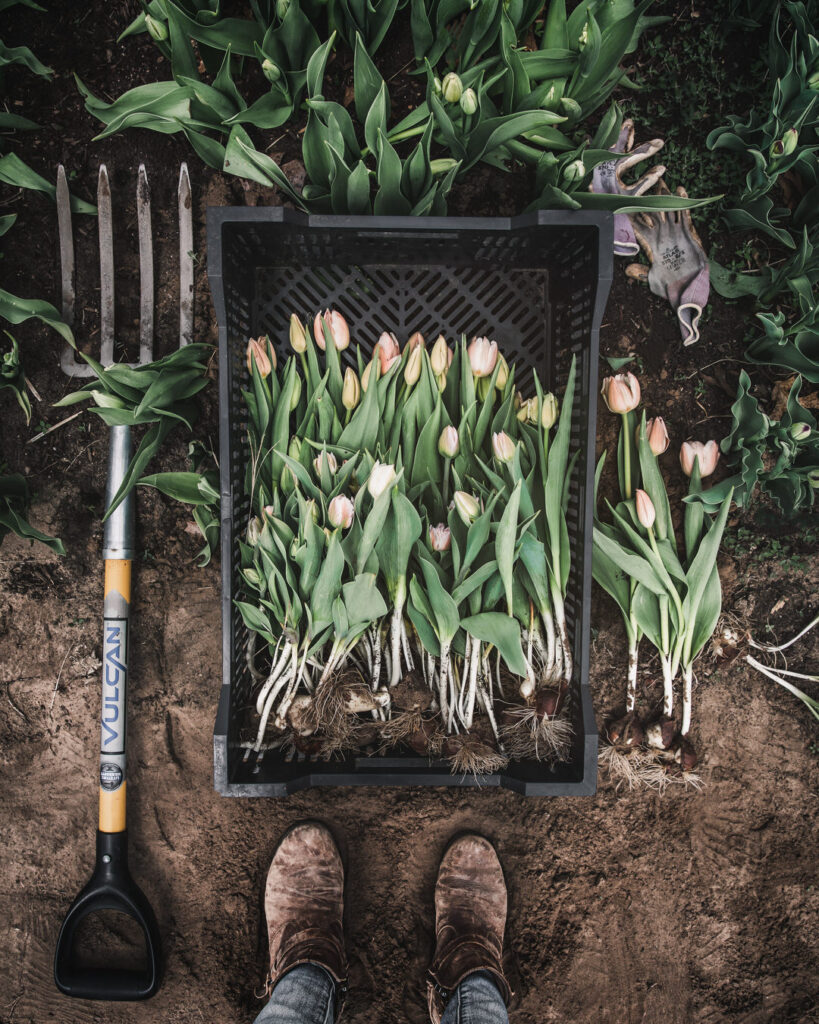
Post-Harvest Treatment and Storage: N&B
Most sources recommend storing tulips dry with their bulbs attached at 32–35F (0–2C). While Postharvest Handling notes tulips can be stored this way for two weeks, many growers report longer storage (including Jennie Love, who has written that she has stored tulips that were harvested at cracked bud stage in a cooler for over a month).
While most growers (including myself) report this, there are little to no data presented to support these claims. For that reason, North Carolina State University sought an ASCFG Research Foundation Grant to provide data on how long tulips could be reliably stored. With that grant, they implemented two ASCFG studies.
The first compared flowers stored with or without the bulb still attached, at either 31 or 33°F. The 31°F temperature was used to explore the option of storing flowers colder than generally recommended. Tulips often sprout and flower well before frost-free dates, so they wanted to test their ability to handle storage temperatures below freezing. The second study’s objective was to see if commercial preservatives could be used to either maintain or increase vase life when used as a pulse prior to storage.
Ultimately, they found that tulips stored for multiple weeks will likely be less wilted and have a longer vase life when the bulb is kept attached. That said, vase life was not drastically different between those with the bulbs versus not (table below). Also interestingly, their results show that in most cases, 31°F better preserved vase life than 33°F. They do concede that most growers will not be able to achieve this temperature, but as with most cuts, the lower the storage temperature, the better preservation of quality. Below is a table of their results:

Post-Harvest Treatment and Storage: BTS
As alluded to above, we store our tulips at 34F for up to a month in the cooler. Since reading the tulip study a few years ago, I aim to harvest with the bulbs attached, but I don’t stress it if they break off and have not noticed much of a difference. Usually, our tulips are sold within a couple weeks from harvest. I’ve only hoarded and stored longer for weddings and events (and in those cases, the flowers only need to last for the event).
If your tulips are especially wilty, you can wrap them in paper and place the stems in water (they should straighten just fine). If we are delivering Fridays, I typically cut the bulbs off either Wednesday evening or Thursday morning, place the stems in water (I pack them in tight so they rehydrate upright, so I don’t mind curvy stems for mason jars), and then I’ll put them together Thursday evening and back into the cooler before Friday morning deliveries.
I think if you’re going to be in the tulip game, a cooler is a must. Once those babies start to go, you need to get them into a cold, dark place right away. For the short term, a refrigerator works (so long as there is not ripening fruit), but you’ll fill that up fast. We actually do use our shop refrigerator at the very-beginning of the season. While it’s really for water/beer, ha, our cooler is converted into a heater for our dahlia tubers over the winter/early spring. So, when the first few tulips started coming out of the high tunnel in early April, we did fill up the refrigerator, but two things happened. One, it filled up really quick, and two, while we were away for a weekend getaway, they FROZE. This is an old refrigerator, but I guess it was close enough to 31F, because much to my surprise, those babies were completely fine. While the study from above notes that 31F is ideal, I think it’s unlikely that most growers coolers/refrigerators would reliably be at this temp. Be careful putting flowers in an old refrigerator.

Pests & Disease: N&B
According to SCF and Johnny’s, the most prominent and serious disease in tulips is Botrytis, which is a fungal disease that causes soft brown spots on leaves, stems, and, flowers. It can progress rapidly and kill large numbers of plants. Reduce the risk of Botrytis by planting in well-drained soil and avoiding overcrowding of plants. Johnny’s also recommends avoiding excess nitrogen, which can weaken plants, and cleaning crop debris from the field each year. All sources also recommend crop rotation.
SCF also mentions Basal rot, which results in red foliage, few roots, and rotted bulbs. They note that this must be controlled by the bulb grower and should never enter the grower’s field. They recommend checking bulbs on arrival for a whitish mold and foul smell. This should not be confused with blue mold (Penicillium) which is generally not serious.
If you experience flower abortion during early stages of development, SCF notes that this can be caused by excessively high temperatures during transportation of the bulbs or ethylene exposure at any point during forcing.
As far as pests, Johnny’s notes that aphids can attack and spread virus.
Pests & Disease: BTS
We have not had any pest or disease problems with our tulips. That said, this year, one variety had what seemed like dried up buds that never produced (Caracas). This was a bit frustrating because I did not order Caracas (they wholesaler sent it in place for Copper Image even after I declined the substitute). Me being me, I didn’t say anything and just planted them. Half in the tunnel and half outside, and both had this issue. All but 3 tulips out of 500. The three that bloomed were actually really beautiful. I would grow it again if I knew this wouldn’t happen. I suspect it was something wrong with the bulbs (heat during transportation?). I do plan on reaching out to the supplier with photos.
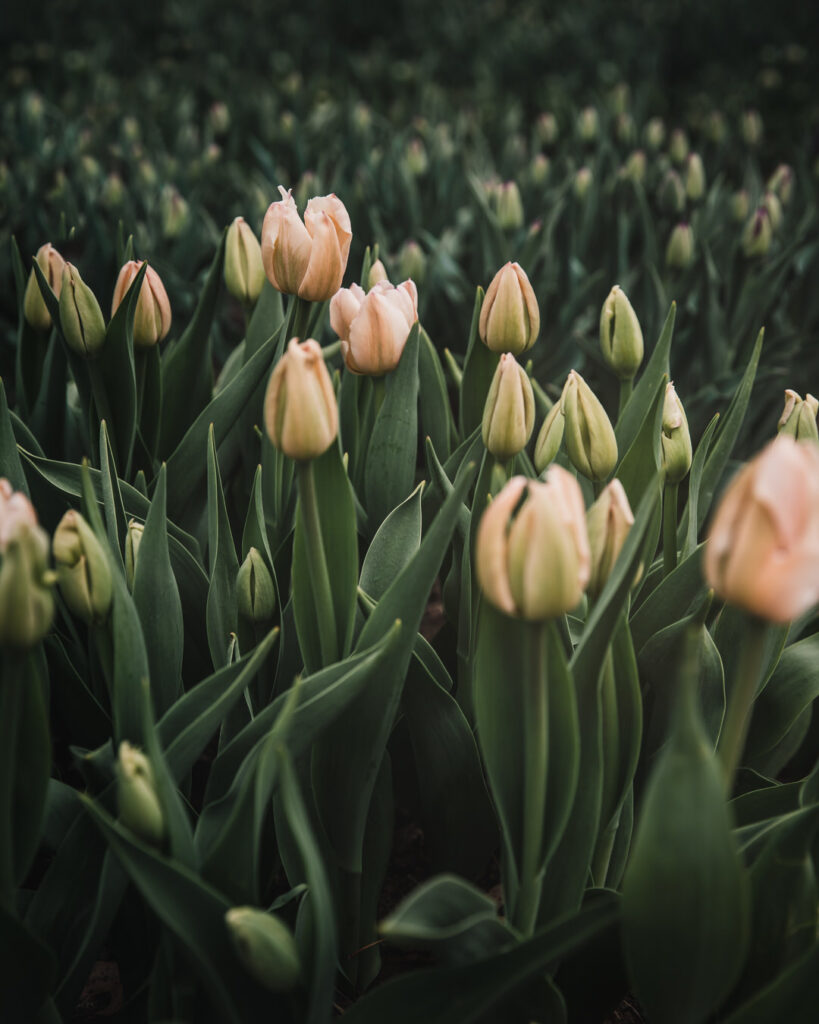
Variety Selection & When/Where to Order: BTS Only
When & Where to Order
Typically, they saying was to order your bulbs for next season when your flowers were blooming. Here in the midwest, I usually ordered earlier than this, but as demand grows in the flower world, orders are happening even sooner. This past fall (2022), I had growing friends tell me they already placed their wholesale order for planting in fall 2023 (i.e., blooms for the 2024 spring season). Ugh, that’s crazy! If that stresses you out, you are not alone.
I did ask our wholesaler (Ball) if that was necessary and/or caused issues for them. My rep said that ordering that early likely isn’t necessary but that ordering early doesn’t really cause an issue for them (the only thing for us as buyers is that prices usually are not available). I placed my order in winter.
Due to order cancellations and delays last fall, my rep did recommend placing orders through different suppliers so as not to have all eggs in one basket. So, I have a variety coming from Ednie and Leo Berbee (all ordered through Ball). I’ve also put in an order with Onings. If this sounds inefficient and like a bit of a logistical nightmare, it kind of is, but I feel like we’re at the mercy of the suppliers at this point.
I share that for anyone ordering wholesale . . . hopefully you can learn from my headaches. And if you have tips for me, please leave em below 🙂
If you aren’t set up to order wholesale, you can order your bulbs retail in the fall. While we’ll be sharing our own personal collection of tulips, narcissus, ranunculus, and anemone bulbs this fall (sign up here for 10% off and email reminders), there are a number of others that do too. I’m not sure if Floret still sells bulbs, but I know that The Farmhouse Flower Farm and The Flower Hat do 🙂 While you’ll pay retail prices, these folks do all the headache wholesale work and you can get really cool varieties in smaller quantities than you’d be able to get wholesale. It’s a good option if you’re just starting out and want to trial a few things before going all in.

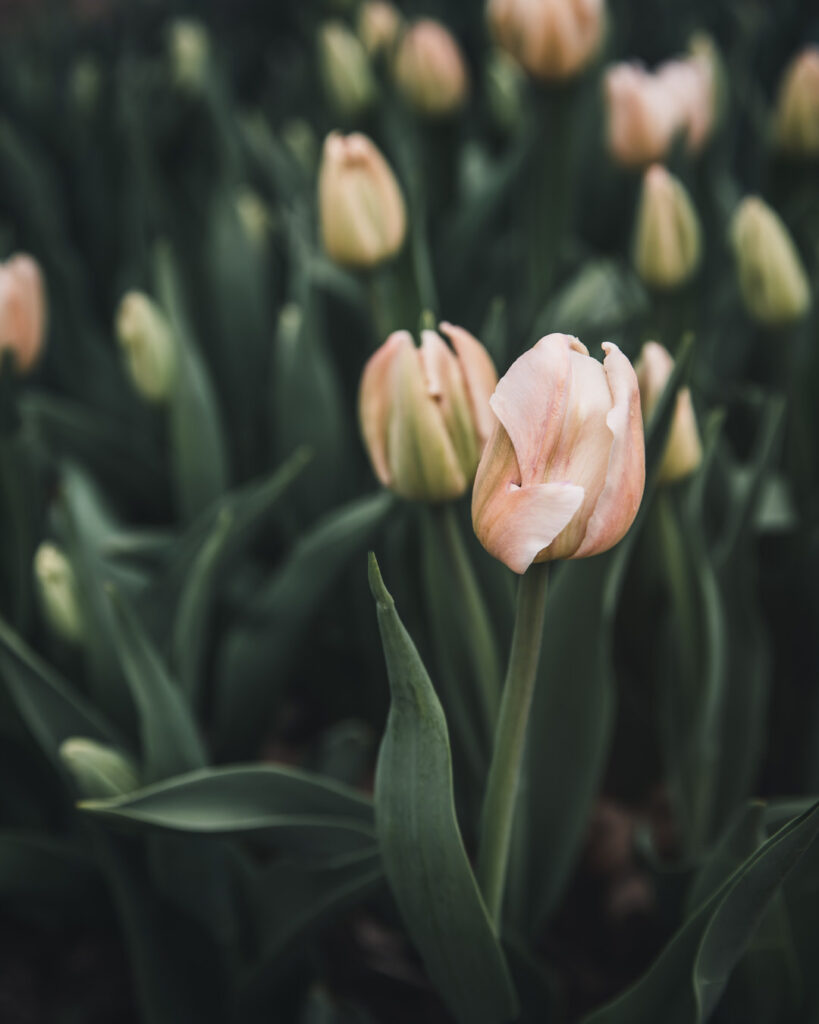
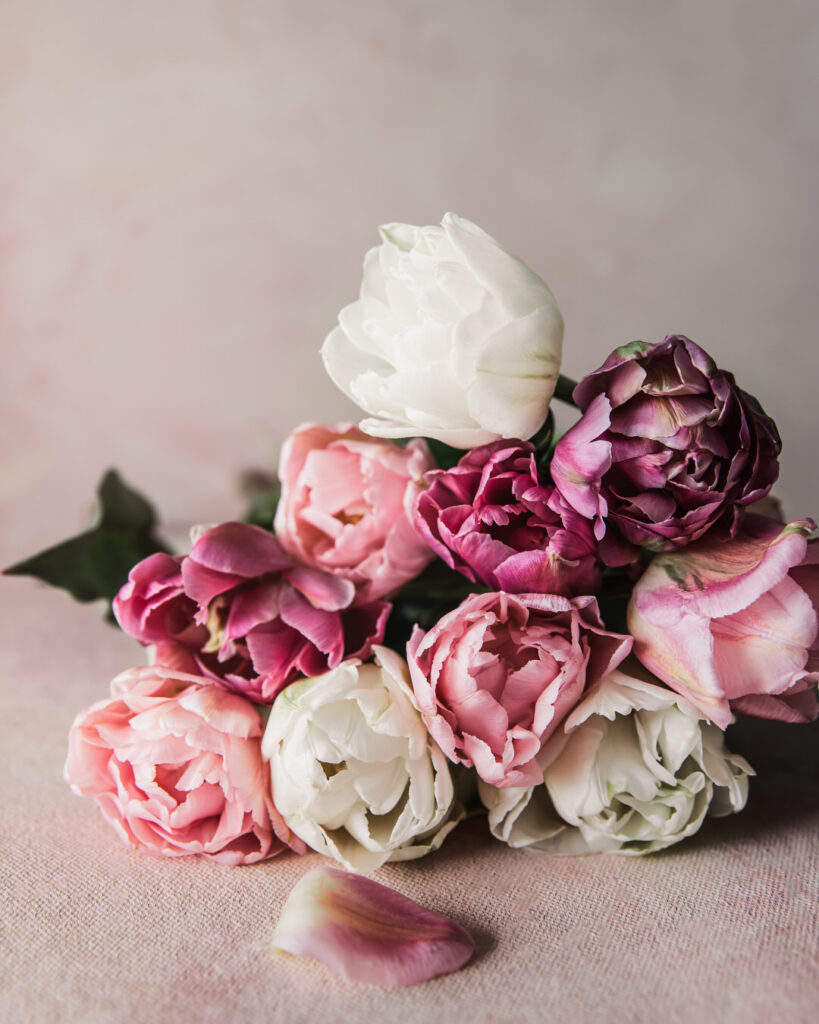
Variety Selection
As noted, I like to grow a variety in multiple groups to help extend the season. You can view this table/comparison chart of our favorite tulips we’ve grown here at the farm. Honestly, I love tulips, so it’s super hard for me to pick top favorites, but I note some in the spreadsheet. My biggest complaint is that tulip season comes and goes in such a flash that I rarely have time to get pictures of them, UGH!
One thing I thought I’d call out is that when I first started, I leaned super heavily toward the unusual tulips (doubles, parrots, fringes, etc.). While I still do, both because I love them and want to stand out from regular supermarket tulips, I think it’s good to mix in standard tulips. Standard tulips have a classic beauty to them, and they are sometimes a better price point than the fancier kinds. I like to mix the unusual and unexpected with the classics, and using more cost-effective bulbs with higher-priced items is ultimately better for the bottom line.

Pricing: N&B
BOSTON Ornamental Terminal Prices as of 16-MAY-2023:
TULIPS: OFFERINGS LIGHT. bunched 10s CD Standard Type long 7.50 Novelty Type long 8.50-8.95
Pricing: BTS
I charge $1.50–$2.00 / stem and that includes to florists (retail being $2). People are hungry for flowers and they are unique (and a lot of work).
Design: BTS Only
I love designing with tulips and the wonkier the stems the better. This is why I don’t mind if some rehydrate crooked. I think they add a lot of character. One thing I’ve learned, though, is that tulip stems can be weaker in bridal bouquets. It’s important to protect them by surrounding them with sturdier stems like stock and make sure they’re not at a weak or compromised point where they can snap. It can also be a little tricky getting their timing right. I want them open and in their full glory but not too far (though even a tulip on the brink of death is really beautiful in my book).
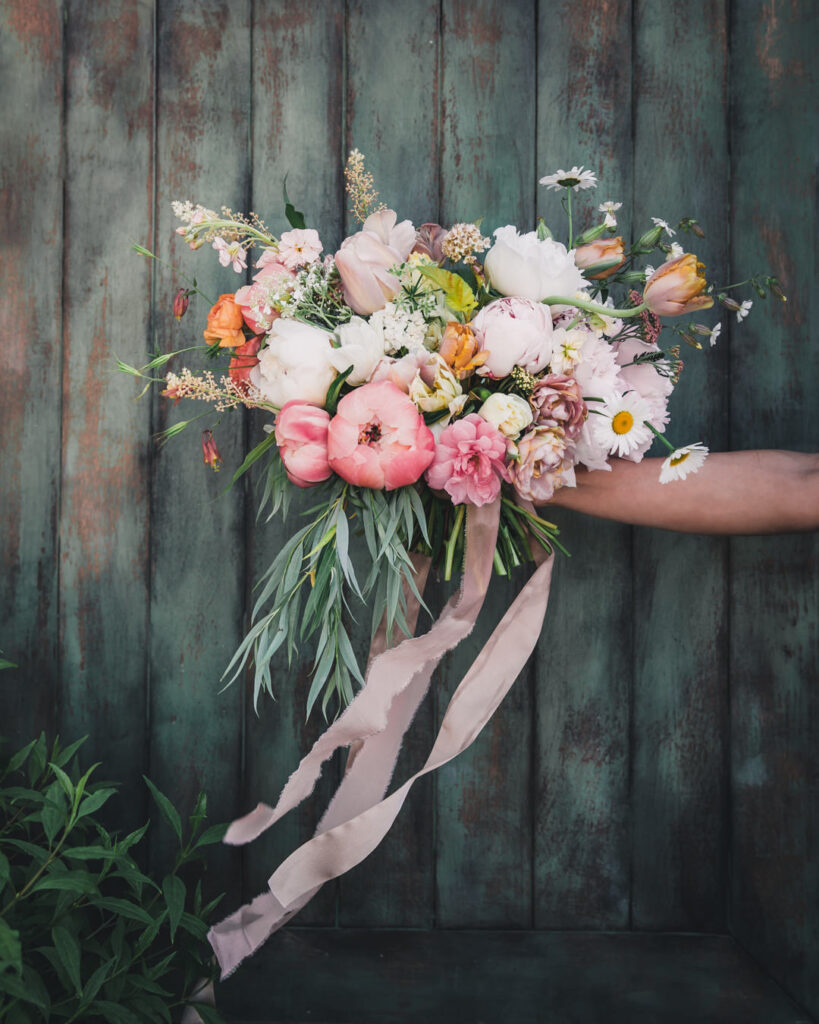
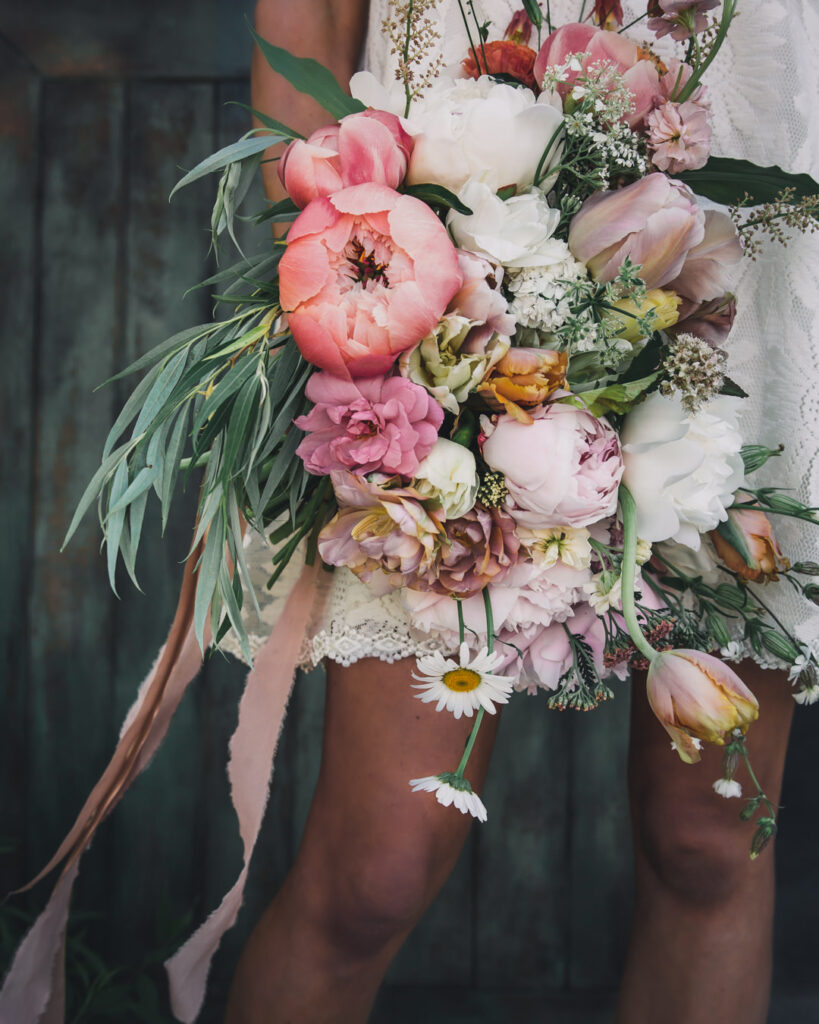
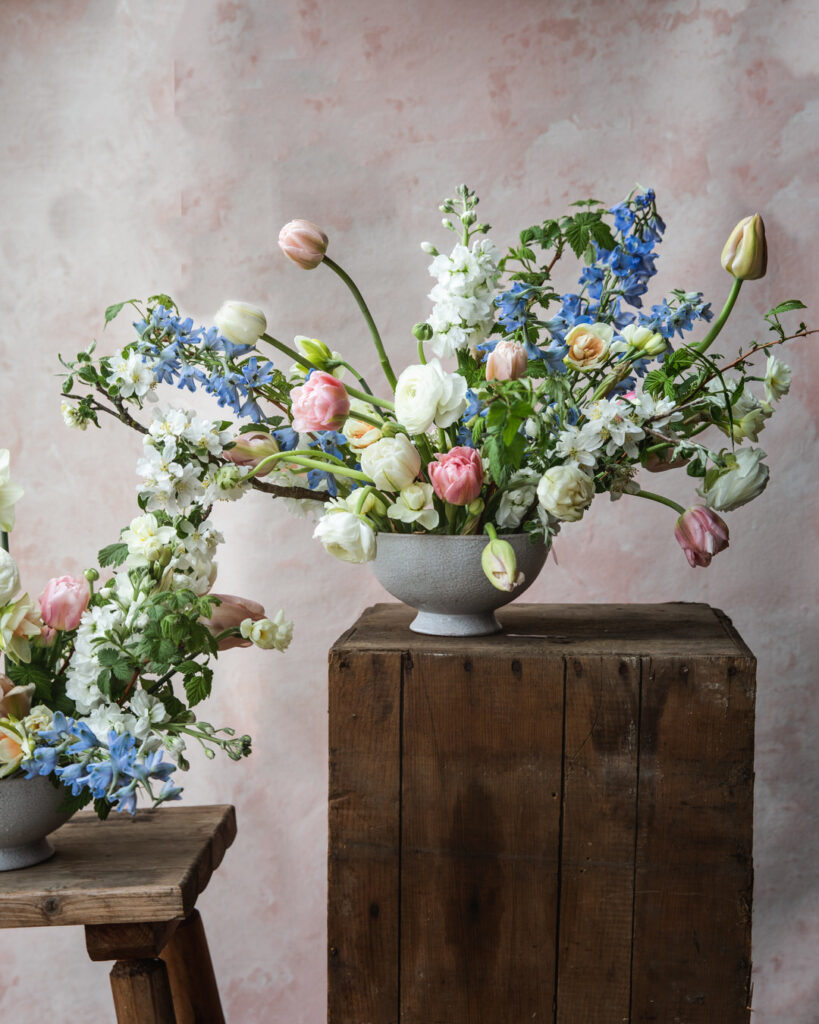
Wrap Up
OK, my friend, that is IT for May’s Plant Profile. What do you think? Did you find some useful nuggets? Is there anything that’s unclear or you wish I would have covered? Or is your head spinning? No worries, you will get a copy of this at the end of June, so you can always refer back it. Tip: use the find shortcut (Ctrl+F on a PC or Command+F on a Mac to search for any word or term).
Have any questions or something you want to share with me or others? I know I say this ad nauseam, but I truly believe in the power of the collective and that we all have something unique and powerful to share, so please leave a question or share a comment below. We’re all better for it, and I thank you in advance!
Cheers pal!
Wondering – after harvesting and storing, and then removing the bulb to use the flower in an arrangment, can the bulb be saved and replanted? Will they have enough stored energy to grow again? Thanks!
Hi, Hailey:
Fabulous question! For the most part, it cannot. In order for the bulb to have enough energy, it needs to remain in the ground with leaves attached to store energy for the following year. According to the research, storing without the bulb only reduces storage time slightly, so you could try pulling up the stem and leaving the bulb and leaves intact (in fact, this happens a lot on accident on our farm, where the stem snaps——we still store the stems and many of those bulbs do come back the following year). Storing without the bulb for the short term is no issue (one consideration would be shorter stem though). That said, many of the fancy tulip varieties that have been bred for cut flower production do not perennialize reliably, so most cut flower producers grow them as annuals. Hope that helps 🙂